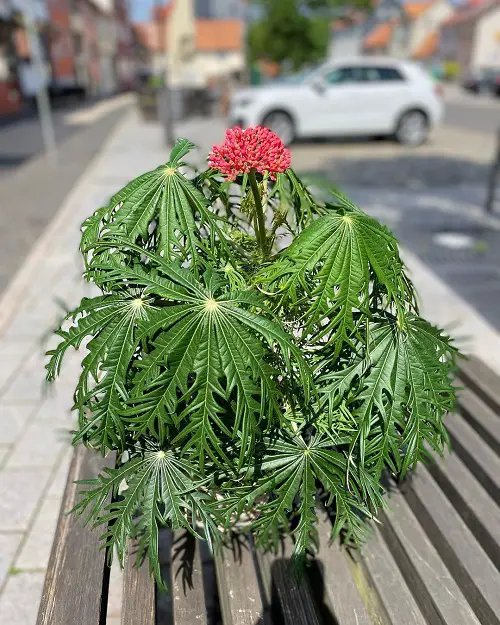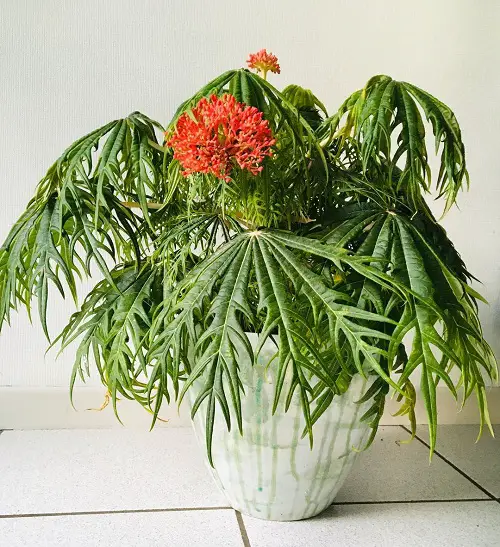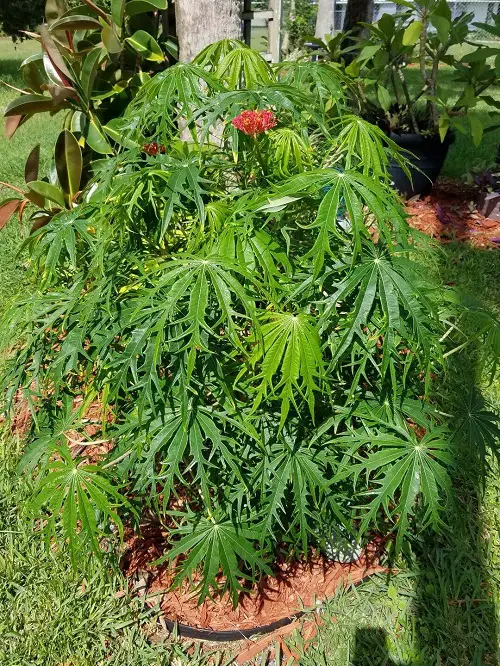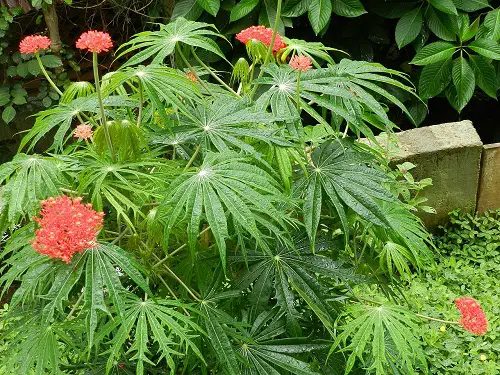Coral Plant is the best way to bring a tropical vibe to your space with its serrated leaves and beautiful red flowers!

The Coral Plant is a stunning tropical shrub that can add a touch of exotic beauty to any garden or indoor space. It gets its name from its attractive coral-like appearance and unique foliage!
USDA Zones: 9-11
Botanical Name: Jatropha multifida
Common Names: Coral Plant, Physic Nut, Guatemala Rhubarb
Find How to Grow Most Fragrant Roses
Coral Plant Information
Coral Plant is a species of flowering shrub in the Euphorbiaceae family. It is native to Central America, South America, and the Caribbean. The plant is characterized by its bright red and orange flowers, which are tubular in shape and grow in clusters. The flowers are followed by large, spiny seed capsules containing the plant’s seeds.
The plant is an evergreen shrub that can grow up to 5 feet (1.5 meters) in height and spread up to 6 feet (2 meters). The leaves are lanceolate in shape and are arranged oppositely along the stems. They are dark green in color, with a pale green underside.
It is popular for its uses as an ornamental plant in gardens and landscapes. It can also be used as a hedge or windbreak. The plant is deer-resistant and also attracts birds, bees, and butterflies to the garden.
Coral Plant Propagation Methods
Growing Coral Plants is a really easy process using cuttings.
- Take stem cuttings in the spring or summer from the tips of the Coral Plant branches.
- Make sure the cutting is at least 4-6 inches long and has a few leaves on it.
- Dip the cut end of the stem in the rooting hormone to promote root development.
- Plant the cutting in a well-draining potting mix, making sure that at least 2 inches of the stem is buried in the soil.
- Water the cutting regularly, keeping the soil moist but not waterlogged.
- Place the pot in a warm and bright location, but protect it from direct sunlight.
- The cutting should develop roots in 4-6 weeks, and it can be transplanted into a larger pot once it has established itself.
Coral Plant Growing Requirements

Light
Plant it in an area that receives at least 5-6 hours of direct sunlight every day. If you are growing coral plants indoors, place them at a location that gets dappled light for the most part of the day.
Growing it in the shade will result in little or no flowers.
Soil
Coral plants prefer well-drained soil that is rich in organic matter. The soil should have a pH of 6.0 to 7.0. If your soil is heavy clay, add some sand or perlite to improve drainage. Before planting, amend the soil with compost or aged manure.
Water
These plants require regular watering, especially during the growing season. Water the plants deeply when the soil feels dry to the touch. Avoid overwatering, as this can lead to root rot.
During winter months, reduce watering to once every two weeks.
Temperature and Humidity
Coral plants prefer warm temperatures and cannot tolerate frost. They thrive in temperatures between 60°F and 80°F (15-26 °C).
If you live in a cooler region, grow coral plants in containers that can be moved indoors during the winter months.
Mist the leaves regularly or place a humidifier nearby. You can also keep its pot on a pebble tray filled with water.
Learn How to Grow Fuchsia Indoors
Coral Plant Care
Fertilizer
Use an all-purpose fertilizer with an N-P-K ratio of 8-12-8. Apply it in the spring and early summer, as it is a warm-season plant. Make sure to read and follow the fertilizer instructions on the package for the best results.
Additionally, adding organic matter such as compost or manure can help to improve the soil structure and fertility of the plant.
Pests and Diseases
Coral plants are susceptible to spider mites and mealybugs. Inspect your plants regularly and treat any infestations immediately. You can use insecticidal soap or neem oil to control these pests.
Coral plants can develop root rot if the soil is too wet. To prevent this, make sure the soil is well-draining and avoid overwatering.
Powdery mildew and leaf spot can also be a problem. Make sure the plant gets plenty of sunlight and air circulation to keep these issues at bay.
Coral Plant Uses
- Ornamental: Jatropha multifida is an attractive shrub with bright red and yellow flowers, making it a popular choice for landscaping.
- Medicinal: The leaves and roots of Jatropha multifida are popular in traditional medicine to treat a variety of ailments, including headaches, fever, and skin conditions.
- Fuel: The seeds are used to produce biodiesel, an alternative fuel source.




